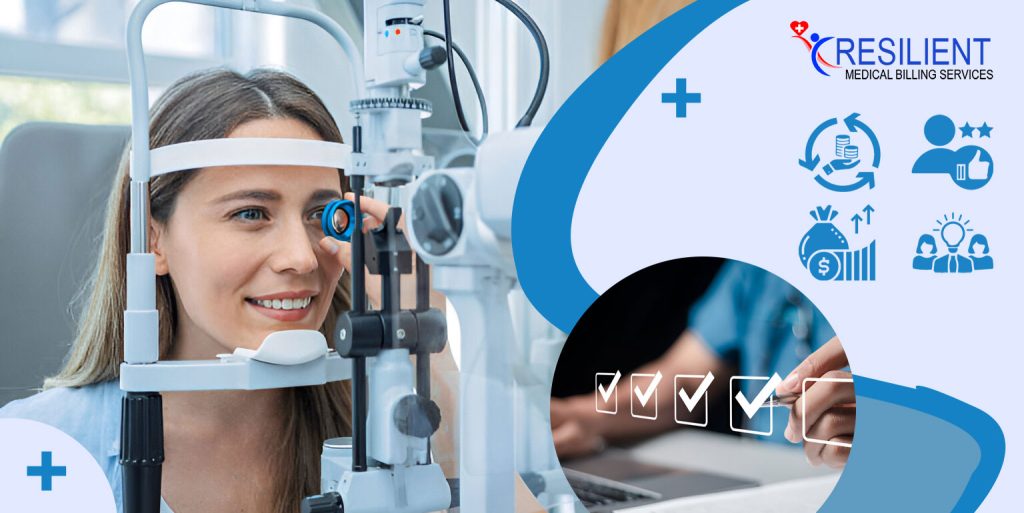CPT codes, including CPT codes for eye exams, are the most significant tools in medical billing and reimbursement in the medical field. These codes, acknowledged by the American Medical Association AMA, categorize and name more than ten thousand services and procedures to avoid confusion in the healthcare facility. It also makes sense to be as precise as possible in CPT codes because mistakes are costly; as research indicates, up to 80% of all medical bills have errors, many of which are in coding and which can cut reimbursement checks by as much as a third.
Vision tests are necessary and are essential medical appointments, as shown by the fact that more than 61% of the population of the United States of America needs glasses or any other eye treatment.
Besides healthy vision, eye tests work as an effective means of diagnosing dangerous diseases, including diabetes, which is a problem for more than 37 million Americans, and hypertension, which affects almost half of the adult population of the USA. For over 15 years, healthcare practitioners have had to use the correct CPT code for eye exams to code eye evaluations appropriately, and failure to do this may result in underpayment, jeopardizing the stability of medical practices.
Understanding CPT Code For Eye Exam
Healthcare providers precisely characterize medical, surgical, and diagnostic operations with five-digit CPT codes. They guarantee medical service documentation is standardized and that providers and insurers agree on services during invoicing.
Eye practitioners utilize CPT codes based on eye test type. The primary comprehensive exam that is CPT code for an Eye exam is 92014, including medical history, examination, and diagnostic testing. This ticket offers extensive services like a complete vision and ocular health evaluation.
For new intermediate eye exam patients, use 92002; for expert patients, use 92012. Each code tells you what level of service was given, ensuring that the bill reflects how complicated and broad the eye exam was.
Healthcare workers must know and use these CPT codes to get compensated for eye treatment.
Ophthalmology CPT code For Eye Exam
Commonly Used Ophthalmology CPT Code For Eye Exam
- 92002–92014: These codes are for eye visits during which an ophthalmologist completes at least three of the 12 elements of the comprehensive eye assessment. They are usually applied in both first-time and follow-up patient encounters.
- 67516: This is a new code for 2024 released on July 1, 2021, in which the injection a pharmacological agent in suprachoroidal space is coded differently from the administration of a pharmacological agent in the vitreous cavity.
CPT Codes, More Specifically, the Evaluation and Management Codes
- G0402: This is a code for new patient office visits with increased work and time required for decision-making compared to 99201.
- 99212–99215: These codes are used for subsequent negotiated visits of established patients and also capture variations in complexity and decision-making time.
- Deleted and Revised Codes: Several older codes have been deleted or reconfigured for 2024 to portray today’s practices and technologies in ophthalmology adequately.
Ophthalmology CPT Codes 2024 Updates
Health codes change with treatments and services. Ophthalmology CPT codes are modified in 2024 to reflect medical advancements, surgery, and clinical procedures. New, revised, or deleted codes may be added in updates. Eye care professionals must watch these changes to ensure proper billing and compliance.
Complex retinal surgery or diagnostic imaging may require new CPT codes. Some eye therapy codes should be modified to reflect better their complexity or specificity for more accurate recording and fairer reimbursement.
Routine Eye Exam: CPT and DX Codes
A routine eye exam fundamentally evaluates a patient’s eye health and vision. It typically involves a series of tests to assess visual acuity, refractive errors, and the eyes’ overall health. During a routine eye exam, an optometrist or ophthalmologist may perform tests like visual field assessment, refraction, and a comprehensive evaluation of eye structures using various diagnostic tools.
Routine Eye Exam CPT Code
The CPT code (Current Procedural Terminology) is essential for accurately documenting the services provided during a routine eye exam. The most commonly used CPT code for an eye exam routine checkup is 92004 for a new patient or 92014 for an established patient. These codes represent a comprehensive eye exam that includes a medical evaluation of the complete visual system.
- 92004: Comprehensive eye examination, including medical evaluation and initiation of diagnostic and treatment programs; new patient.
- 92014: Comprehensive eye examination, including medical evaluation and initiation of diagnostic and treatment programs; established patient.
Routine Eye Exam DX Code
The DX code (Diagnosis code), often represented by ICD-10 (International Classification of Diseases, 10th Edition) codes, describes the reason for the eye exam. For routine eye exams, the common diagnosis CPT code for eye exams is Z01.00 or Z01.01:
- Z01.00: Encounter for examination of eyes and vision without abnormal findings.
- Z01.01: Encounter for examination of eyes and vision with abnormal findings.
Importance of Accurate CPT and DX Codes for Insurance Claims
Insurance claims require accurate CPT and DX code documentation. Precise coding reduces claim denials and guarantees billing compliance. Using the correct CPT and DX codes for routine eye exams shows genuine service and supports its medical necessity.
Insurance companies use these codes to assess coverage and reimbursement. Regular and correct coding is crucial to keep the clinic financially stable and ensure patients receive their benefits.
Read More: ICD-10 Code for Spinal Fusion
Final Words!
Ophthalmology practices depend on accurate eye exam coding, including the CPT code for eye exams, patient care, and revenue management. Correct CPT and DX codes streamline insurance claims processing, lowering denials and payment delays. Ophthalmologists must stay abreast of coding and billing changes as the specialty evolves. You may optimize billing and run your practice efficiently by doing so.
If billing within your ophthalmology practice needs to be improved, consider employing billing specialists or outsourcing ophthalmology services to assist. Resilient MBS offers comprehensive billing services for accurate coding and revenue cycle improvement.
Resilient MBS helps you avoid mistakes in the CPT code for eye exams; we’re waiting for your call. Discover our CPT code and billing practice information to stay on top of the emerging trends in ophthalmic billing.










